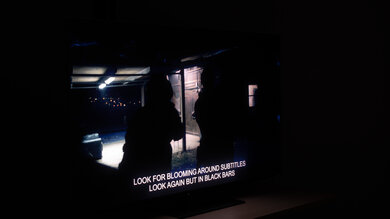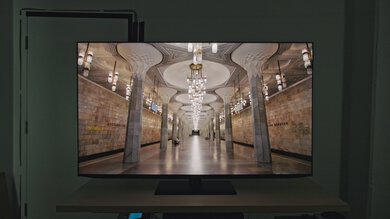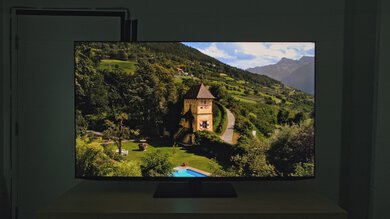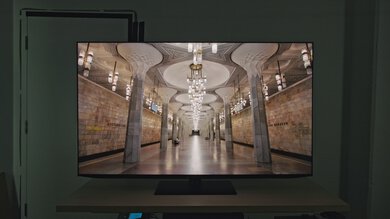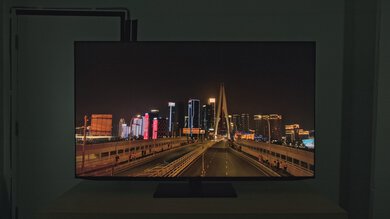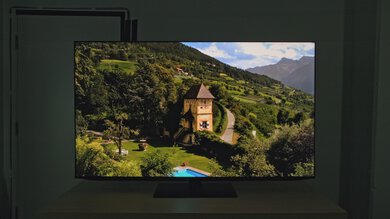The Sharp AQUOS XLED FV1 is part of Sharp's premium AQUOS line-up. It uses Deep Chroma QD technology that is designed to provide the brightness of an LCD TV with contrast close to that of an OLED. It includes Dolby Vision IQ to adjust the picture brightness based on the amount of ambient light in a room and has over 2000 dimming zones that are meant to precisely control the backlight for effective local dimming. The TV has Sharp's ARSS+ speaker system, which has 11 speakers built-in with a maximum output of 85W, and it supports both DTS and Dolby Digital passthrough, as well as Dolby Atmos. It's only available in 65-inch and 75-inch sizes.
Our Verdict
The Sharp AQUOS XLED is very good for mixed usage. HDR content is impactful thanks to its fantastic contrast and amazing HDR brightness, so blacks are deep, and highlights stand out well. It can easily overcome glare thanks to its amazing SDR brightness and good reflection handling, so it's a good option for a bright room. The TV pairs well with modern gaming consoles due to its HDMI 2.1 bandwidth, 4k @ 120Hz, and VRR support, and its excellent response time provides clear motion with minimal blur behind quick-moving objects, although it does struggle more coming out of dark states. Unfortunately, the TV has a narrow viewing angle, so it's not a great choice for watching TV with friends, as anyone watching from the side sees a degraded image.
- Amazing HDR peak brightness for impactful highlights.
- Deep blacks due to the TVs fantastic contrast.
- Amazing SDR brightness to easily overcome glare.
- Image is degraded from the sides due to its narrow viewing angle.
- Low-resolution content is soft due to poor upscaling.
The Sharp AQUOS XLED is decent for watching TV shows. Its built-in Google TV interface is loaded with a huge selection of streaming apps, so it's easy to find your favorite shows. The TV has amazing SDR brightness and good reflection handling, so it can easily overcome glare in a bright room. Unfortunately, it has a narrow viewing angle, so it's not a good choice if you like to move around your room while watching TV, as the image is degraded when viewed from the sides. Its sharpness processing is poor, so low-resolution content from DVDs or other standard-definition sources is soft and lacks sharpness.
- Amazing SDR brightness to easily overcome glare.
- Low-quality content smoothing helps to remove artifacts from low bitrate content.
- Image is degraded from the sides due to its narrow viewing angle.
- Very inaccurate colors due to bad pre-calibration accuracy.
- Low-resolution content is soft due to poor upscaling.
The Sharp AQUOS XLED is satisfactory for watching sports. Fast-moving players and objects are clear with minimal blur due to its excellent response time, and the TV can easily overcome glare in a bright room thanks to its amazing SDR brightness and good reflection handling. The TV has a good gray uniformity, which means there's only a little bit of the dirty screen effect that can be distracting when watching sports with large areas of the same color, like hockey. Unfortunately, it has a narrow viewing angle, so it's not a good choice for watching the game with friends, as anyone not centered in front of the screen sees a degraded image.
- Amazing SDR brightness to easily overcome glare.
- Low-quality content smoothing helps to remove artifacts from low bitrate content.
- Image is degraded from the sides due to its narrow viewing angle.
- Very inaccurate colors due to bad pre-calibration accuracy.
- Low-resolution content is soft due to poor upscaling.
The Sharp AQUOS XLED is great for playing video games. The TV's excellent response time provides clear motion with minimal blur behind quick movements, and its excellent input lag means there's no discernable delay between your controller inputs and what happens on screen. It looks great in a dark room thanks to its fantastic contrast, so blacks are deep, and they stay that way when brighter highlights are on screen. The TV can easily overcome glare in a bright room thanks to its amazing SDR brightness and good reflection handling, so it's also great for gaming in a bright room. The TV has HDMI 2.1 bandwidth on two of its ports for 4k @ 120Hz gaming and also supports VRR, so it's a great option to pair with modern gaming consoles.
- Deep blacks due to the TVs fantastic contrast.
- VRR issues with frame rates above 105fps.
- Very inaccurate colors due to bad pre-calibration accuracy.
The Sharp AQUOS XLED is very good for watching movies in a dark room. The TV has fantastic contrast, so blacks are deep, and they stay that way when highlights are on screen due to its effective local dimming feature, even though there's some blooming. Highlights in HDR really stand out due to the TV's amazing HDR brightness, and its wide color gamut means colors are vibrant and lifelike despite there being some banding. The TV can also remove 24p judder from any source for a judder-free moving watching experience, and its very good low-quality content smoothing helps to smooth out artifacts in content from low-quality sources, like cable boxes or heavily compressed streams. Unfortunately, its pre-calibration accuracy is bad, so if you want accurate colors, the TV needs to be calibrated.
- Supports Dolby Vision and advanced DTS audio formats.
- Amazing HDR peak brightness for impactful highlights.
- Deep blacks due to the TVs fantastic contrast.
- Low-quality content smoothing helps to remove artifacts from low bitrate content.
- Image is degraded from the sides due to its narrow viewing angle.
- Low-resolution content is soft due to poor upscaling.
The Sharp AQUOS XLED is impressive for HDR gaming. It looks great in a dark room thanks to its fantastic contrast, so blacks are deep, and they stay that way when brighter highlights are on screen. The TV also has amazing HDR brightness, so highlights really pop the way they should. Fast motion has minimal blur due to its excellent response time, and its low input lag provides a responsive gaming experience with no noticeable delay between controller inputs and what happens on screen. The TV is a good option to pair with modern gaming consoles due to its HDMI 2.1 bandwidth for 4k @ 120Hz gaming and VRR support for a nearly tear-free gaming experience.
- Amazing HDR peak brightness for impactful highlights.
- Deep blacks due to the TVs fantastic contrast.
- VRR issues with frame rates above 105fps.
The Sharp AQUOS XLED is very good for use as a PC monitor. It has amazing SDR brightness and good reflection handling, so it can easily overcome glare in a bright room. The TV's low input lag provides a responsive experience, so there's no discernible delay between the actions on your mouse and keyboard and what happens on screen. Unfortunately, the TV has a narrow viewing angle, so the sides of the screen aren't consistent with the center when you sit close. Although the TV can properly display chroma 4:4:4 at 60Hz, it can't properly display it at 120Hz, so you don't get clear text if you want the highest refresh rate the TV offers. Finally, the TV has an excellent response time, so there's minimal blur behind quick-moving objects, but it's slower coming out of dark states, so there's some black smudging when scrolling through text.
- Amazing SDR brightness to easily overcome glare.
- Doesn't support chroma 4:4:4 in 120Hz.
- Image is degraded from the sides due to its narrow viewing angle.
- Very inaccurate colors due to bad pre-calibration accuracy.
Changelog
- Updated Aug 13, 2024: Mentioned the newly reviewed LG QNED90T in the Pre-Calibration section of this review.
- Updated Mar 12, 2024: Review published.
- Updated Mar 06, 2024: Early access published.
- Updated Feb 27, 2024: Our testers have started testing this product.
Check Price
Differences Between Sizes And Variants
We bought and tested the 65-inch Sharp AQUOS XLED (4T-C65FV1U), but our results are also valid for the 75-inch model.
| Size | US Model | International Model Code | Dimming Zones |
|---|---|---|---|
| 65" | 4T-C65FV1U | 4T-C65FV1X | 2160 |
| 75" | 4T-C75FV1U | 4T-C75FV1X | 2304 |
You can see the label for our unit here.
Popular TV Comparisons
The Sharp AQUOS XLED is a very good TV overall, but it's held back by its issues with VRR, lack of chroma 4:4:4 @ 120Hz support, narrow viewing angle, bad pre-calibration accuracy, small selection of sizes, and expensive price tag. The FV1 isn't anything special, and you can get similar performance from the cheaper Sony X90L or better overall performance from the cheaper Hisense U8/U8K.
For more options, check out our recommendations for the best QLED TVs and the best 4k TVs, or if you need something smaller, check out our article on the best 55-inch TVs.
The Sharp AQUOS XLED FV1 and the Sony X90L/X90CL are similar TVs, each with their own strengths. The Sharp has better contrast and black uniformity, so it looks better in a dark room, and highlights in HDR content stand out a bit more on it due to its better HDR peak brightness. However, the Sony TV has better processing, so it upscales low-resolution content much better, has less banding in HDR content, and has lower input lag. The Sony also has much better pre-calibration accuracy, so you don't have to get it calibrated if you care about color accuracy.
The Hisense U8K and the Sharp AQUOS XLED FV1 are similar TVs, but the Hisense is cheaper and outperforms the Sharp. The Hisense has a higher contrast ratio and better black uniformity with less blooming and haloing, so it looks better in a dark room. The Hisense also has significantly better pre-calibration accuracy, so colors in SDR are much closer to the content creator's intent. On top of that, the Hisense is better for PC gamers due to its 4k @ 144Hz support.
The LG C3 OLED is better than the Sharp AQUOS XLED FV1. The LG has a quicker response time for less blur behind quick motion, and its lower input lag provides a more responsive gaming or desktop experience. The LG is also better suited for watching TV as a group due to its much wider viewing angle, and it's also better suited for a dark room due to its higher contrast ratio and better black uniformity.
The Sharp AQUOS XLED FV1 and the Sharp AQUOS FS1 OLED are better than each other in different ways. The FS1 is better suited for a dark room due to its nearly infinite contrast ratio and perfect black uniformity, and it's the better option for a group setting due to its much wider viewing angle. The FS1 also has a quicker response time, so there is less blur behind quick-moving objects. However, the FV1 is better suited for a well-lit room due to its much higher SDR brightness, so it can overcome more glare, and its higher HDR brightness makes highlights stand out more in HDR content.
Test Results

The back of the TV is bulky and is made entirely of plastic. Some of the inputs face the sides, and they aren't set into the TV, so they're accessible when it's wall-mounted. There's a tie on the back of the TV as well as a channel on the back of the stand that can be used to help with cable management.
The Sharp AQUOS XLED TV has fantastic contrast with local dimming enabled. Blacks are deep when viewed in a dark room, and they stay that way when highlights are on screen. With local dimming disabled, the TV's contrast is mediocre, and blacks appear raised and washed out when highlights are on screen.
The TV has good overall lighting zone transitions, but it does struggle with very fast-moving content. The leading edge of quick-moving objects is visibly dimmer, and there's noticeable haloing.
The Sharp AQUOS XLED has amazing HDR brightness. Highlights really pop out during dark scenes, and the TV gets bright enough for very bright specular highlights to stand out in well-lit scenes.
These measurements are after calibrating the HDR white point with the following settings:
- HDR Picture Mode: Movie HDR
- Backlight: 100
- Brightness: 50
- Contrast: 50
- Saturation: 50
- Local Dimming: High
- Color Temperature: Warm
- Gamma: Middle
- Adaptive Luma Control: Off
- Color Space: Auto
The TV has excellent HDR brightness in Game Mode, but it's visibly dimmer than Movie Mode.
These measurements are after calibrating the HDR white point with the following settings:
- HDR Picture Mode: Game HDR
- Backlight: 100
- Brightness: 50
- Contrast: 50
- Saturation: 50
- Local Dimming: High
- Game Mode: On
- Color Temperature: Warm
- Gamma: Middle
- Adaptive Luma Control: Off
- Color Space: Auto
The Sharp AQUOS XLED TV has outstanding PQ EOTF tracking. Blacks and some midtones are slightly brighter than intended, and some shadows, midtones, and highlights are a bit darker than intended, but the TV displays HDR content very close to the content creator's intent. There's a roll-off near the TV's peak brightness to maintain some details in very bright highlights.
The Sharp AQUOS XLED has amazing SDR brightness. It's bright enough to overcome glare in well-lit rooms easily.
These measurements are after calibration with the following settings:
- Picture Mode: Movie
- Backlight: 100
- Brightness: 50
- Contrast: 45
- Saturation: 50
- Local Dimming: High
- Color Temperature: Warm
- Gamma: Middle
- Color space: Auto
The Sharp AQUOS XLED TV has an excellent HDR color gamut. It has fantastic coverage of the commonly used DCI-P3 color space, and its coverage of the wider Rec. 2020 color space that is increasing in popularity is excellent. Most colors are a bit off in both spaces, with reds, greens, and yellows faring the worst.
The Sharp AQUOS XLED has outstanding color volume. The TV displays a wide range of colors at high luminance levels, and dark saturated colors are displayed well due to its fantastic contrast.
The Sharp AQUOS XLED TV has bad pre-calibration accuracy. The color temperature is too cool, and the white balance is very off, with noticeable accuracy errors throughout mid-grays and whites and an overrepresentation of reds and blues. Gamma is also off, with dark scenes being too dark and brighter scenes being too bright. Colors are very inaccurate across the board, with yellows, cyans, and whites being the most off.
If you want a TV with much better pre-calibration SDR accuracy, take a look at the LG QNED90T.
The TV has incredible accuracy after calibration. White balance is only slightly off now, and gamma is much closer to the 2.2 target, with only dark scenes being slightly too dark and some bright scenes being slightly too bright. Color temperature is much closer to the D65 white point and color accuracy is much better across the board.
You can see our full calibration settings here.
The TV has good gray uniformity. There's some slight vignetting in the corners, and there's some visible dirty screen effect towards the center of the screen, which is most noticeable when watching sports with large areas of the same color, like hockey and football.
The TV has an inadequate viewing angle. The image is dimmer, faded, and washed out as you move off-center, so it's not a good choice for a wide seating arrangement, as anyone sitting off to the sides sees a severely degraded image.
The TV has good reflection handling. Its semi-gloss finish greatly reduces the impact of indirect reflections caused by overhead lights, and it also does a good job of reducing glare from direct reflections, like from a lamp placed directly in front of the screen. The TV can easily overcome glare in a bright room.
The Sharp AQUOS XLED has okay HDR gradient handling. There's visible banding in darker shades of green and blue, with very noticeable banding across all grays. Other colors have minimal banding.
Unfortunately, the TV has poor sharpness processing with low-resolution and low-bitrate content. The image isn't very clear or sharp, finer details are mostly lost, and small hard-coded text is hard to make out.
Sharpness processing was calibrated with no over-sharpening for low-resolution or low-bitrate content with the following settings:
- Sharpness: 10
- AISR: Middle
The TV uses a BGR (blue-green-red) subpixel layout. This doesn't cause issues with normal content, but it causes text clarity issues when you use the TV as a PC monitor. However, there are easy workarounds for these issues that you can read about here.
The Sharp AQUOS XLED uses pulse width modulation (PWM) to dim its backlight. It flickers at a relatively low 320Hz in all picture modes and at all brightness levels. This is low enough to be noticeable to those who are sensitive to it, especially since it doesn't flicker in time with the TV's refresh rate.
The TV doesn't have an optional backlight strobing feature, commonly known as black frame insertion (BFI), to help reduce persistence blur.
The TV has optional motion interpolation to help smooth out low frame rate content, but it doesn't work very well. Even slower-moving scenes have noticeable artifacts present, and it struggles so much with faster scenes that it has a screen-tearing type effect with haloing around characters.
Due to the TV's quick response time, there's noticeable stutter when watching movies or TV shows, and it's most noticeable in slow panning shots.
The TV automatically removes judder from all sources with no additional settings required.
The TV supports all three VRR formats, so it has great compatibility regardless of the source. Unfortunately, we encountered an unusual tearing effect near the bottom of the screen with frame rates above 105fps in both 1080p and 4K, which you can see here.
Due to the aforementioned issue, the effective VRR range is 20Hz-105Hz, since anything above that causes screen-tearing.
The Sharp AQUOS XLED has excellent input lag when set to Game Mode. Although it's not as low as many other TVs on the market, it's still low enough to provide a responsive gaming experience.
The TV supports all common resolutions up to 4k @ 120Hz on two of its four HDMI ports. It also displays 1080p and 4K @ 60Hz @ 4:4:4, which is essential for clear text from a PC. Unfortunately, the TV can't properly display 4:4:4 in both 1080p and 4K @ 120Hz.
As long as you're using HDMI ports 3 or 4, the TV is compatible with almost everything the Xbox Series X|S offers. Unfortunately, the TV can't do 4k @ 120Hz with Dolby Vision enabled, so if you want to play in Dolby Vision, you're limited to 60Hz. It also doesn't support 1440p @ 120Hz.
The Sharp AQUOS XLED supports HDR10, HLG, and Dolby Vision but doesn't support the less common HDR10+. Unfortunately, HDMI 2.1 bandwidth is limited to HDMI ports 3 and 4. HDMI 3 is also the eARC port, so if you have a soundbar or receiver plugged into it, you're only left with one port capable of HDMI 2.1 bandwidth, which is limiting.
The TV supports eARC, which lets you pass high-quality, uncompressed audio to a compatible receiver or soundbar through an HDMI cable. It supports most major audio formats, so you don't have to worry about compatibility with external sources. Unfortunately, it doesn't support LPCM 7.1 and is limited to LPCM 2.0.
The TV has an alright frequency response. Dialogue sounds clear enough, but the TV doesn't get very loud and lacks meaningful bass. You will want to pair it with a decent soundbar or surround sound system if you want proper bass and louder overall volume.
The TV's distortion handling is mediocre. It doesn't get very loud, but there's audible distortion when listening at louder volumes, and the distortion increases as you approach max volume.
The Sharp AQUOS XLED has a fantastic selection of apps, so it's easy to find your favorite content. You can also cast content from your phone onto the TV or play videos directly from a USB stick.
The TV has a nice remote with dedicated buttons for the most popular streaming services. It also has a physical number pad for those who need buttons to change channels. The remote has a built-in microphone for voice commands, but we couldn't get it to work properly. Google Assistant activates when pressing the microphone button, but the remote won't pick up any voices. We don't know for sure if the issue is isolated to our remote or not.









